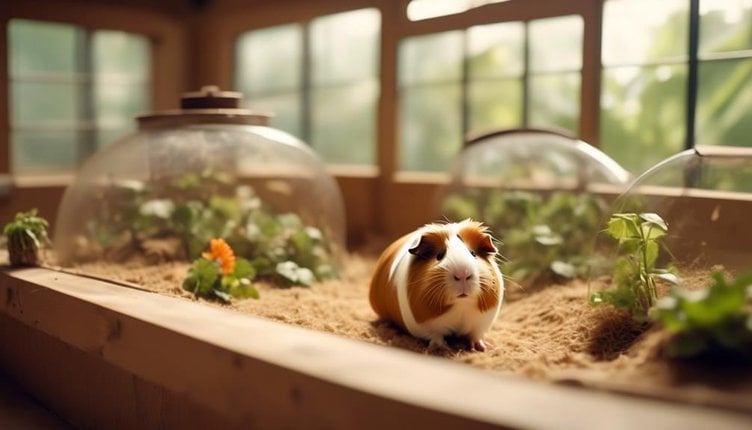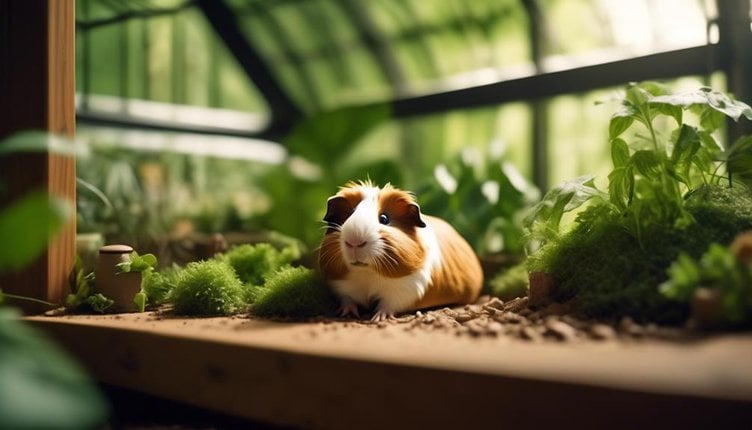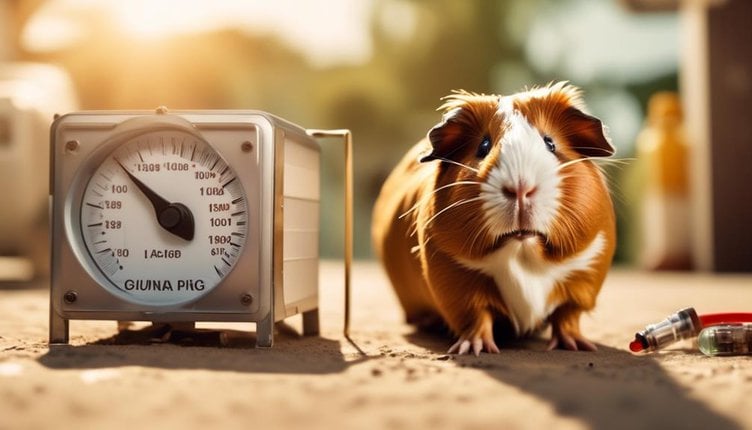Hey there! Let’s talk about heatstroke in guinea pigs. These adorable little creatures are just too precious, and we need to make sure they stay safe and comfy, especially when the heat gets intense.
Now, guinea pigs might seem all cuddly and cute, but they’re actually quite vulnerable to high temperatures. As the mercury rises, so does the risk of heatstroke for these furry buddies. But don’t worry, my friend, I’ve got some tips to help you prevent heatstroke and handle it if it happens.
First things first, let’s focus on prevention. Keeping your guinea pig cool and comfortable is absolutely crucial. Make sure they have plenty of shade and fresh water available at all times. You can also place a cool towel or ice pack near their cage to create a refreshing environment. And hey, if you have air conditioning, lucky you! Set it to a comfortable temperature for your little buddy.
Now, let’s say the worst happens and your guinea pig shows signs of heatstroke. It’s time to take action, my friend. Move them to a cool area immediately and place a damp towel on their body to help bring down their body temperature. You can also give them small sips of water, but don’t force them to drink. And remember, time is of the essence, so get in touch with a veterinarian right away for further guidance.
So, my friend, keep these tips in mind and be proactive in keeping your guinea pig cool and comfortable. With a little care and attention, you can ensure their well-being even in scorching conditions. Stay cool, my friend!
Key Takeaways
- Providing shade options and cooling accessories is crucial for preventing heatstroke in guinea pigs.
- Recognizing the signs and symptoms of heatstroke, such as excessive panting and drooling, is important for early intervention.
- Constant access to fresh water and water-rich fruits and vegetables helps prevent dehydration and mitigate the risk of heatstroke.
- Proper ventilation and creating a cool environment, including using fans or misting the enclosure, are essential in temperature control for guinea pigs.
Importance of Temperature Control
Proper temperature control is crucial for preventing heatstroke in guinea pigs. Guinea pigs are highly susceptible to heatstroke due to their inability to regulate body temperature effectively. Therefore, providing shade options and cooling accessories is essential to ensure their well-being.
One of the key factors in preventing heatstroke is the availability of shade options. Guinea pigs should have access to a shaded area at all times, especially during hot weather. This can be achieved by placing their cage in a cool, well-ventilated room or by providing them with a sheltered outdoor area. The shade will help them escape direct sunlight and reduce the risk of overheating.
In addition to shade, cooling accessories play a vital role in maintaining a comfortable temperature for guinea pigs. These accessories, such as cooling mats or ceramic tiles, can provide a cool surface for them to lie on. Another option is to use frozen water bottles wrapped in a towel, which can be placed in their cage to create a cooling effect. These accessories help dissipate heat and prevent heatstroke.
Signs and Symptoms of Heatstroke
Recognizing the signs and symptoms of heatstroke in guinea pigs is crucial for prompt intervention and treatment. Guinea pigs are highly susceptible to heatstroke due to their inability to regulate body temperature efficiently. Here are the signs and symptoms to watch out for:
- Excessive panting: Guinea pigs will exhibit rapid, shallow breathing and may struggle to catch their breath.
- Lethargy and weakness: Heatstroke can cause your guinea pig to become sluggish, with reduced energy levels and difficulty moving.
- Drooling and wet fur: Excessive salivation and damp fur are common signs of heatstroke in guinea pigs.
- Red or pale gums: Pay attention to any changes in the color of your guinea pig’s gums, as this can indicate heatstroke.
- Convulsions or seizures: In severe cases, guinea pigs may experience seizures or convulsions due to heatstroke.
Dehydration prevention is crucial in mitigating the risk of heatstroke. Ensure your guinea pig has constant access to fresh water and keep their environment cool and well-ventilated. If you suspect heatstroke, immediate treatment is essential. Move your guinea pig to a cooler area, offer them water to drink, and gently wet their fur with cool (not cold) water. Contact a veterinarian as soon as possible for further guidance and medical assistance.
Proper Ventilation for Guinea Pigs

Guinea pigs require adequate ventilation to maintain optimal health and prevent the risk of respiratory problems. Proper ventilation is of utmost importance as it helps to remove stagnant air, dust, and other harmful particles from their environment. Good ventilation also helps regulate the temperature and humidity levels, ensuring a comfortable and safe living space for these small animals.
To provide adequate ventilation for guinea pigs, it’s essential to choose the right housing setup. Enclosures should have proper airflow, allowing fresh air to circulate while preventing drafts. Wire mesh or slatted flooring can help improve ventilation by allowing air to flow from underneath. Placing the enclosure in a well-ventilated area, away from direct sunlight and high humidity, is also crucial.
In addition to proper housing, cooling methods can be employed to maintain a suitable environment for guinea pigs. Placing a fan or providing air conditioning can help regulate the temperature during hot weather. Using a damp cloth or misting the enclosure with water can also aid in cooling down the surrounding air.
Ensuring the proper ventilation and implementing cooling methods are essential in maintaining the health and well-being of guinea pigs. By creating an environment with adequate airflow and temperature control, the risk of respiratory problems and heatstroke can be significantly reduced.
Hydration Tips for Preventing Heatstroke
To ensure the well-being of guinea pigs in hot weather, it’s crucial to prioritize their hydration needs and implement effective strategies to prevent heatstroke. Proper hydration is essential for guinea pigs to regulate their body temperature and avoid heat-related illnesses. Here are some hydration tips for preventing heatstroke in guinea pigs:
- Provide fresh and clean water: Make sure to offer your guinea pig fresh and clean water at all times. Check the water bottle or bowl regularly to ensure that it isn’t empty or contaminated.
- Offer watery fruits and vegetables: Include fruits and vegetables with high water content in your guinea pig’s diet. Cucumber, watermelon, and lettuce are excellent choices as they help keep your pet hydrated.
- Use a misting spray: Spraying a fine mist of water in your guinea pig’s enclosure can help cool down the environment. Be careful not to spray directly on the guinea pig, as it may cause stress or discomfort.
Creating a Cool Environment for Guinea Pigs

To create a cool environment for guinea pigs, temperature control methods should be implemented. This includes ensuring proper ventilation and using fans or air conditioning when necessary.
Providing shade options is also important. This can be done by placing the cage in a shaded area or using umbrellas or covers to block out direct sunlight.
Using cooling accessories for cages can further help keep guinea pigs cool. This includes placing frozen water bottles or ceramic tiles in the cage, which provide a cool surface for the guinea pigs to rest on.
Temperature Control Methods
In order to create a cool environment for guinea pigs, it’s important to implement effective temperature control methods.
Here are some temperature control techniques and heatstroke prevention measures that can help:
- Provide proper ventilation in the guinea pig’s living area to ensure adequate air circulation.
- Place the enclosure away from direct sunlight and sources of heat such as radiators or heating vents.
- Use a fan or air conditioner to maintain a comfortable temperature during hot weather.
These measures are crucial in preventing heatstroke in guinea pigs.
By implementing these temperature control methods, you can create a cool and safe environment for your furry friends, ensuring their well-being and happiness.
Providing Shade Options
Shade options can be provided to create a cool environment for guinea pigs. Ensuring that guinea pigs have access to shade is crucial in preventing heatstroke and keeping them comfortable. There are various cooling methods that can be implemented to provide shade for these small animals. One effective way is to use a shaded area or enclosure made of materials that block direct sunlight. Another option is to use umbrellas or canopies to create a shaded spot for the guinea pigs. Additionally, placing the guinea pig’s enclosure in a shaded area or using shade cloths can provide relief from the sun’s heat. By providing these shade options, guinea pig owners can help keep their pets cool and reduce the risk of heatstroke.
| Shade Options | Cooling Methods |
|---|---|
| Shaded area | Use of materials |
| Umbrellas | Canopies |
| Shaded enclosure | Shade cloths |
Cooling Accessories for Cages
Cooling accessories can be added to guinea pig cages to create a cool and comfortable environment for these small animals. Here are three options to consider:
- Cooling mats: These mats are specifically designed to dissipate heat and provide a cool surface for guinea pigs to rest on. They’re made from materials that help regulate temperature, such as gel or water-filled pads. Simply place the mat in the cage, and your guinea pigs can enjoy a refreshing spot to lie down.
- Frozen water bottles: Fill a plastic water bottle with water and freeze it. Once frozen, wrap the bottle in a towel or cloth and place it in the cage. The frozen bottle will release a cooling effect, helping to lower the temperature in the cage.
- Ceramic tiles: Ceramic tiles are naturally cool and can provide a cool surface for guinea pigs to lie on. Place the tiles in the cage, and your guinea pigs can enjoy the coolness they provide.
Emergency Care for Heatstroke

If a guinea pig is experiencing heatstroke, immediate action must be taken to provide emergency care. Heatstroke in guinea pigs is a serious condition that requires prompt intervention to prevent further complications and potentially save the animal’s life.
The first step in emergency care for heatstroke is to remove the guinea pig from the hot environment and place it in a cool, well-ventilated area. It’s crucial to bring down the body temperature of the guinea pig as quickly as possible. This can be achieved by gently wetting the guinea pig’s fur with cool water or wrapping it in a damp towel. It’s important to avoid using cold water or ice, as this can cause shock or other adverse reactions.
Additionally, offering the guinea pig cool water to drink can help rehydrate the animal. Once the guinea pig’s body temperature starts to normalize, it’s recommended to seek veterinary assistance for further evaluation and treatment.
Seeking Veterinary Assistance
Seek immediate veterinary assistance when a guinea pig is experiencing heatstroke. Veterinary expertise is crucial in providing the necessary care and treatment for a guinea pig suffering from heatstroke. Here are three reasons why seeking veterinary assistance is essential:
- Prompt diagnosis and treatment: Veterinarians have the knowledge and experience to accurately diagnose heatstroke in guinea pigs. They can assess the severity of the condition and provide appropriate treatment, which may include cooling measures, fluid therapy, and monitoring vital signs.
- Preventing complications: Heatstroke can lead to various complications, such as organ damage, respiratory distress, and dehydration. Veterinary professionals can intervene promptly to prevent or manage these complications, ensuring the best possible outcome for the guinea pig.
- Heatstroke prevention guidance: In addition to treating heatstroke, veterinarians can also provide valuable guidance on heatstroke prevention. They can educate guinea pig owners on appropriate housing conditions, avoiding high temperatures, and recognizing early signs of heat stress. By following this guidance, owners can take proactive measures to prevent heatstroke in their guinea pigs.
Seeking veterinary assistance is crucial for the well-being of guinea pigs suffering from heatstroke. The expertise of veterinarians ensures prompt diagnosis, treatment, and prevention of complications, ultimately improving the chances of a full recovery for these beloved pets.
Frequently Asked Questions
Can Guinea Pigs Get Heatstroke Even if They Are Kept Indoors?
Guinea pigs can indeed get heatstroke even if kept indoors. It is important to understand the signs and symptoms of heatstroke in guinea pigs and take preventive measures to ensure their well-being.
Are Certain Guinea Pig Breeds More Prone to Heatstroke Than Others?
Certain guinea pig breeds may have a higher susceptibility to heatstroke due to their genetic makeup. However, with proper heatstroke prevention techniques such as providing shade and fresh water, the risk can be minimized for all breeds.
Can Guinea Pigs Develop Long-Term Health Issues After Experiencing Heatstroke?
Guinea pigs can experience long-term health issues after suffering from heatstroke. The recovery process may vary, and it is important to monitor their condition closely. Prompt veterinary care and proper cooling techniques can help minimize the potential long-term effects.
Is It Safe to Use a Fan or Air Conditioner to Cool Down a Guinea Pig?
Using a fan or air conditioner is safe for cooling guinea pigs. They cannot tolerate extreme temperatures and need proper ventilation. These methods help regulate their body temperature and prevent heatstroke.
Are There Any Medications or Supplements That Can Help Prevent Heatstroke in Guinea Pigs?
Some medications and supplements may help prevent heatstroke in guinea pigs. However, it is important to consult with a veterinarian before using them. Natural remedies, such as providing shade and fresh water, are also effective preventive measures.






